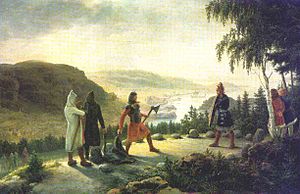
Back Holmgang Czech Holmgang Danish Holmgang German Holmgang Spanish Holmgang Finnish Holmgang French Holmgang Italian 홀름강가 Korean Holmgang Dutch Holmgang NN

Holmgang (Old Norse: holmganga, Icelandic: hólmganga, Danish and Norwegian: holmgang, Swedish: holmgång) is a duel practiced by early medieval Scandinavians. It was a legally recognized way to settle disputes.
The name holmgang (literally "holm-going") may derive from the combatants' dueling on a small island, or holm, as they do in the saga of Egill Skallagrímsson, alternatively figuratively in reference to an arena.
At least in theory, anyone offended could challenge the other party to holmgang regardless of their differences in social status. This could be a matter of honor, ownership or property, demand of restitution or debt, legal disagreement or intention to help a wife or relative or avenge a friend.
Holmgangs were fought 3–7 days after the challenge. If the person challenged did not turn up for the holmgang, the other man was considered just in his challenge. If the offended party did not turn up for the holmgang, they were deemed niðingr, and could have been sentenced to outlawry. In effect, if someone was unwilling or unable to defend their claim, they had no honor. Sometimes a capable warrior volunteered to fight in the place of a clearly outclassed friend.
© MMXXIII Rich X Search. We shall prevail. All rights reserved. Rich X Search